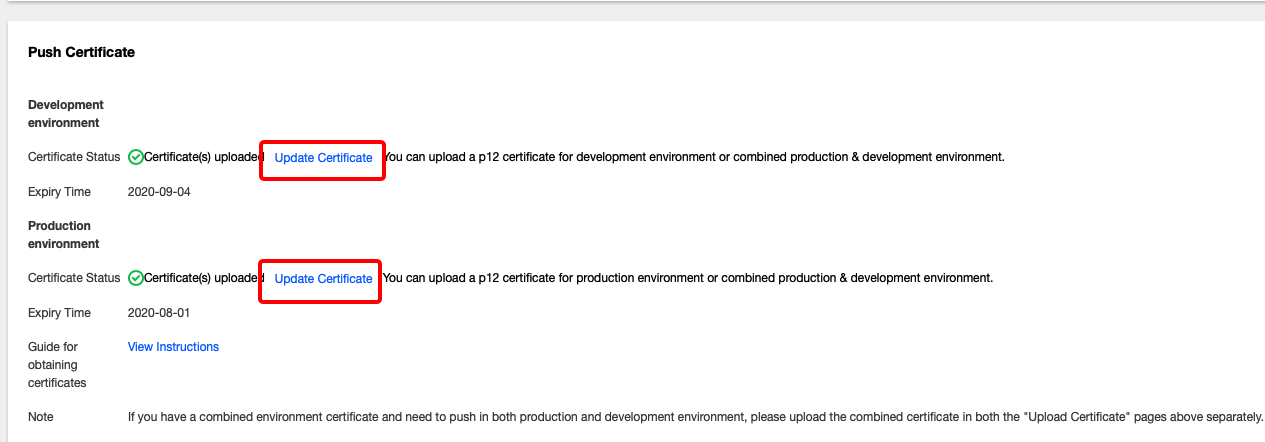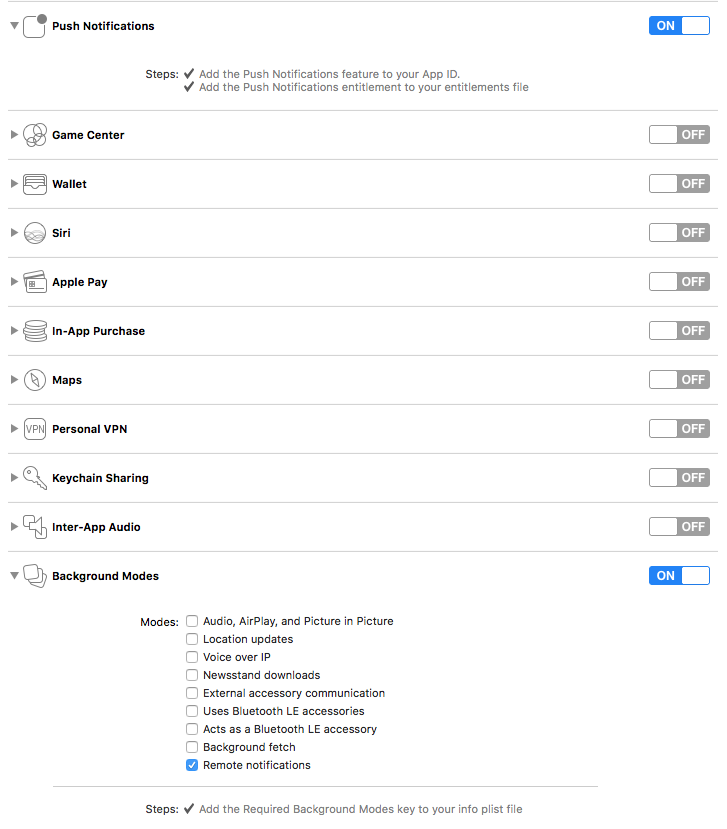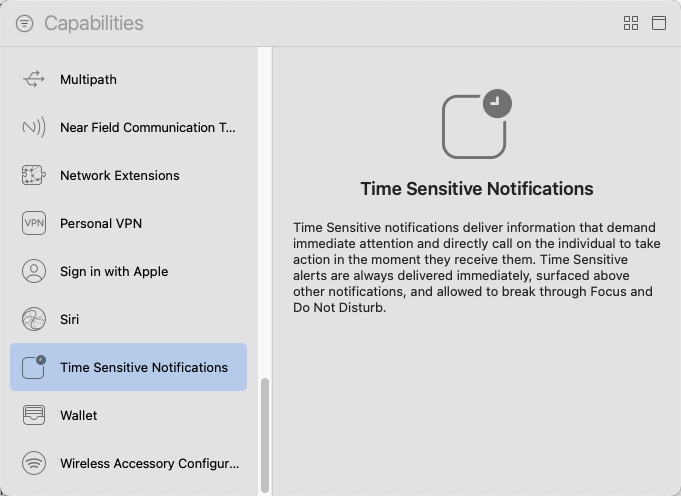Overview
This document provides sample code for integrating with the TPNS SDK and launching the TPNS service (SDK version: v1.0+).
SDK Composition
doc folder: contains the development guide of the TPNS SDK for iOS.
demo folder: contains demo projects and the TPNS SDK (only the OC demo is included. For the Swift demo, please go to TGit).SDK Integration
Preparing for integration
2. Click Configuration Management to go to the management page.
4. After the certificate is uploaded, get AccessID and AccessKey from the application information column.
Importing the SDK (two methods)
Method 1. Import through CocoaPods
Download through CocoaPods:
pod 'TPNS-iOS', '~> version' // If the version is not specified, the latest version of the local pod `TPNS-iOS` will be downloaded
Note:
For a first download, you need to log in to TGit to set the username and password on the Account page. After successful setting, you only need to enter the corresponding username and password in the terminal, and you do not need to log in again on the current PC. Due to the change of the repository address, if the pod prompts Unable to find a specification for 'TPNS-iOS', you need to run the following command to update the repository and confirm the version:
pod repo update
pod search TPNS-iOS
pod install // Install the SDK
Method 2. Import manually
1. Log in to the TPNS console and click SDK Download in the left sidebar to go to the download page. Select the SDK version to download, and click Download in the Operations column. 2. Open the SDK folder under the demo directory. Add XGPush.h and libXG-SDK-Cloud.a to the project. Open the XGPushStatistics folder and obtain XGMTACloud.framework.
3. Import the InAppMessage folder into the project and add the search path in Build Setting > **Framework Search Paths (if your SDK version is below 1.2.8.0, you can skip this step).
4. Add the following frameworks to Build Phases:
* XGInAppMessage.framework
* XGMTACloud.framework
* CoreTelephony.framework
* SystemConfiguration.framework
* UserNotifications.framework
* libXG-SDK-Cloud.a
* libz.tbd
* CoreData.framework
* CFNetwork.framework
* libc++.tbd
5. After the frameworks are added, the library references are as follows:
Project configuration
1. Open the push notification in the project configuration and backend modes, as shown in the following figure:
To use the "Time Sensitive Notifications" feature introduced in iOS 15, please enable Time Sensitive Notifications in Capabilities.
2. Add the compilation parameter -ObjC.
If checkTargetOtherLinkFlagForObjc reports an error, it means that -ObjC has not been added to Other link flags in build setting. Note:
If the service access point of your application is Guangzhou, the SDK implements this configuration by default. The domain name for Guangzhou is tpns.tencent.com.
If the service access point of your application is Shanghai, Singapore, or Hong Kong (China), please follow the step below to complete the configuration:
Decompress the SDK file package, add the XGPushPrivate.h file in the SDK directory to the project, and reference to it (#import "XGPushPrivate.h") in the class that needs to configure the domain name.
Call the domain name configuration API in the header file before calling the startXGWithAccessID:accessKey:delegate: method.
To integrate with the Shanghai service access point, set the domain name to tpns.sh.tencent.com.
Example
[[XGPush defaultManager] configureClusterDomainName:@"tpns.sh.tencent.com"];
To integrate with the Singapore service access point, set the domain name to tpns.sgp.tencent.com.
Example
/// @note TPNS SDK1.2.7.1+
[[XGPush defaultManager] configureClusterDomainName:@"tpns.sgp.tencent.com"];
To integrate with the Hong Kong (China) service access point, set the domain name to tpns.hk.tencent.com.
Example
/// @note TPNS SDK1.2.7.1+
[[XGPush defaultManager] configureClusterDomainName:@"tpns.hk.tencent.com"];
To integrate with the Guangzhou service access point, set the domain name to tpns.tencent.com.
Example
/// @note TPNS SDK1.2.7.1+
[[XGPush defaultManager] configureClusterDomainName:@"tpns.tencent.com"];
Integration sample
Call the API for launching TPNS and implement the method in the XGPushDelegate protocol as needed to launch the push service.
1. Launch TPNS. The AppDelegate sample is as follows:
@interface AppDelegate () <XGPushDelegate>
@end
-(BOOL)application:(UIApplication *)application didFinishLaunchingWithOptions:(NSDictionary *)launchOptions
{
[[XGPush defaultManager] startXGWithAccessID:<your AccessID> accessKey:<your AccessKey> delegate:self];
return YES;
}
2. In AppDelegate, choose to implement the method in the XGPushDelegate protocol:
- (void)xgPushDidReceiveRemoteNotification:(nonnull id)notification withCompletionHandler:(nullable void (^)(NSUInteger))completionHandler{
}
- (void)xgPushDidReceiveNotificationResponse:(nonnull id)response withCompletionHandler:(nonnull void (^)(void))completionHandler {
}
Notification Service Extension Plugin Integration
The SDK provides the Service Extension API, which can be called by the client to use the following extended features:
Collect precise statistics of message arrivals through the APNs channel.
Receive images and audiovisual rich media messages through the APNs channel.
Note:
If the Service Extension API is not integrated, arrival statistics cannot be collected for the APNs channel.
Debugging Method
Enable debug mode
After enabling debug mode, you can view the detailed TPNS debug information on the device for troubleshooting.
Sample code
// Enable debugging
[[XGPush defaultManager] setEnableDebug:YES];
Implementing the XGPushDelegate protocol
During debugging, it is recommended that you implement the following method in the protocol to obtain detailed debugging information.
- (void)xgPushDidRegisteredDeviceToken:(nullable NSString *)deviceToken xgToken:(nullable NSString *)xgToken error:(nullable NSError *)error;
- (void)xgPushDidFailToRegisterDeviceTokenWithError:(nullable NSError *)error {
}
Observing logs
If the Xcode console displays a log similar to the one below, the client has properly integrated the SDK.
[TPNS] Current device token is 9298da5605c3b242261b57****376e409f826c2caf87aa0e6112f944
[TPNS] Current TPNS token is 00c30e0aeddff1270d8****dc594606dc184
Note:
Use a TPNS 36-bit token for pushing to a single target device.
Unified Message Receipt Callback and Unified Message Click Callback
Unified message receipt callback for the TPNS and APNs channels: this callback will be triggered when the application receives a notification message in the foreground and receives a silent message in all states (foreground, background, and shutdown).
- (void)xgPushDidReceiveRemoteNotification:(nonnull id)notification withCompletionHandler:(nullable void (^)(NSUInteger))completionHandler;
Note:
By default, no banner appears when your application receives a notification in the foreground. To show the banner, add the sample code as below:
if ([notification isKindOfClass:[UNNotification class]]) {
completionHandler(UNNotificationPresentationOptionBadge | UNNotificationPresentationOptionSound | UNNotificationPresentationOptionAlert);
}
When the application receives a notification message in the foreground or a silent message in all states, the unified message receipt callback xgPushDidReceiveRemoteNotification will be triggered.
The following is the sample code for differentiating the receipt of a notification message in the foreground or a silent message in all states.
NSDictionary *tpnsInfo = notificationDic[@"xg"];
NSNumber *msgType = tpnsInfo[@"msgtype"];
if (msgType.integerValue == 1) {
/// Receipt of a notification message in the foreground
} else if (msgType.integerValue == 2) {
/// Receipt of a silent message
} else if (msgType.integerValue == 9) {
/// Receipt of a local notification (TPNS local notification)
}
Unified message click callback: this callback applies to the notification messages of the application in states (foreground, background and shutdown).
/// Unified message click callback
/// @param response will be `UNNotificationResponse` for iOS 10+/macOS 10.14+, or `NSDictionary` for earlier versions.
/// @note TPNS SDK1.2.7.1+
- (void)xgPushDidReceiveNotificationResponse:(nonnull id)response withCompletionHandler:(nonnull void (^)(void))completionHandler;
Note:
The unified message receipt callback xgPushDidReceiveRemoteNotification of the TPNS will process message receipt and then automatically call the application:didReceiveRemoteNotification:fetchCompletionHandler method, which, however, may also be hooked by other SDKs.
If you have integrated only the TPNS platform, you are advised not to implement the system notification callback method; use only the TPNS notification callback method instead.
If you have integrated multiple push platforms and need to process the services of other platforms using the application:didReceiveRemoteNotification:fetchCompletionHandler method, please see the following guidelines to avoid repeated service processing:
You need to distinguish between message platforms. After getting the message dictionary in the two message callback methods, use the xg field to tell whether it is a TPNS message. If it is a TPNS message, process it using the xgPushDidReceiveRemoteNotification method; otherwise, process it using the application:didReceiveRemoteNotification:fetchCompletionHandler method.
If both xgPushDidReceiveRemoteNotification and application:didReceiveRemoteNotification:fetchCompletionHandler are executed, then completionHandler needs to be called only once in total. If it is also called by other SDKs, make sure that it is called only once overall; otherwise, crashes may occur.
Advanced Configuration (Optional)
Suggestions on getting the TPNS token
After you integrate the SDK, we recommend you use gestures or other methods to display the TPNS token in the application's less commonly used UIs such as About or Feedback. The console and RESTful API requires the TPNS token to push messages. Subsequent troubleshooting will also require the TPNS token for problem locating.
Sample code
// Get the token generated by TPNS.
[[XGPushTokenManager defaultTokenManager] xgTokenString];
Suggestions on getting TPNS running logs
After integrating the SDK, you are advised to use gestures or other methods to display TPNS running logs in the app’s less commonly used UI such as About or Feedback. Doing so will facilitate subsequent troubleshooting.
Sample code
[[XGPush defaultManager] uploadLogCompletionHandler:^(BOOL result, NSString * _Nullable errorMessage) {
NSString *title = result ? NSLocalizedString(@"report_log_info", nil) : NSLocalizedString(@"failed", nil);
if (result && errorMessage.length>0) {
UIPasteboard *pasteboard = [UIPasteboardgeneralPasteboard];
pasteboard.string = errorMessage;
}
[TPNSCommonMethodshowAlert:title message:errorMessage viewController:selfcompletion:nil];
}];





































